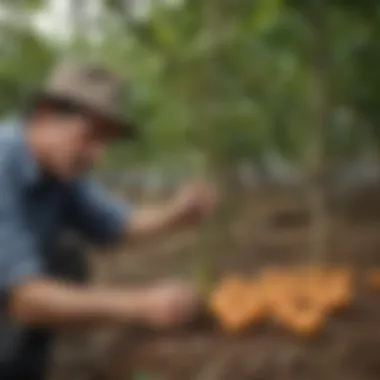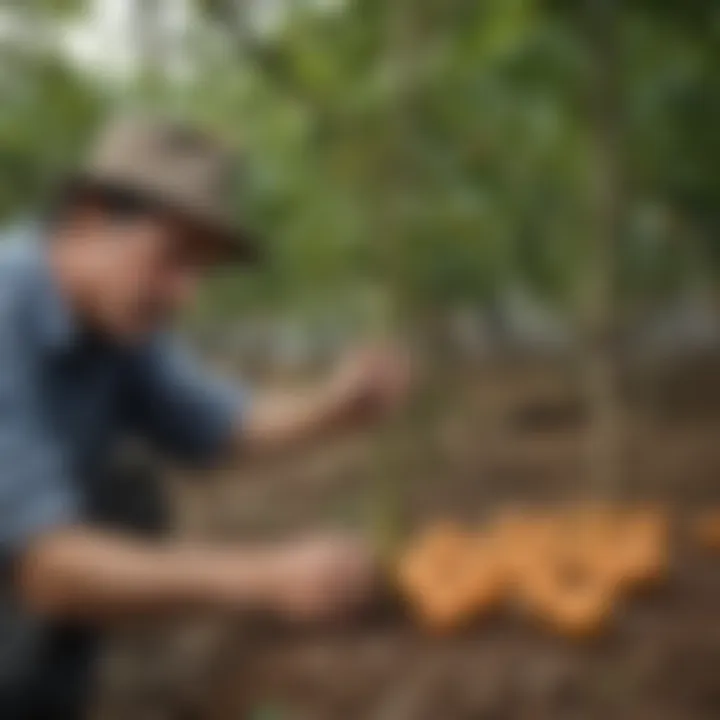Grafting Papaya Trees: Techniques and Benefits


Summary of Objectives
The purpose of this article is to examine the practice of grafting papaya trees. Through a detailed analysis, it will provide insights on various grafting techniques, the selection of rootstocks and scions, and the optimal environmental conditions that contribute to successful grafting. Each point will relate back to the primary goal of enhancing fruit production and improving disease resistance.
Importance of the Research
Understanding the grafting of papaya trees is essential for both commercial growers and hobbyist gardeners. The techniques covered in this article are vital for anyone looking to cultivate papayas successfully. As papaya cultivation becomes more significant in agricultural sectors, knowing the intricacies of grafting contributes not only to better yields but also to sustainable farming practices.
Intro
Grafting is a critical horticultural technique used widely by papaya growers. This process involves combining tissues from two different plants to create a new organism with desirable traits from both parents. It has great potential in improving the fruit yield and disease resistance of papaya trees.
The method of grafting can be complex yet rewarding. It requires a good understanding of the compatibility between various rootstocks and scions. A rootstock refers to the lower part of the graft, which forms the root system, while the scion is the upper part that results in the fruit-bearing branches.
Several methods accompany the grafting process, each with its own set of challenges and benefits. Those who master these techniques can thrive in evolving agricultural landscapes.
Techniques of Grafting Papaya Trees
Selecting Rootstocks and Scions
Choosing the right rootstock is crucial. Generally, rootstocks need to be resilient to local soil conditions and diseases. For papayas, rootstocks such as Solo or Hawaii can be particularly effective.
Scions should be selected from healthy plants that display desirable traits, such as high fruit quality or early maturity. It is important to trim the scion properly to increase the chances of successful grafting.
Grafting Methods
- Side-Graft Method: Involves making a cut on the side of the rootstock and inserting the prepared scion.
- Cleft Graft: This technique is useful when the rootstock is significantly thicker than the scion. It involves cutting the rootstock down the middle and placing the scion firmly into the cleft.
- Whip and Tongue Graft: This joins both rootstock and scion at a slant, allowing them to fit into each other securely.
Each method has its own merits and can be selected based on specific situations and desired outcomes.
Optimal Conditions for Grafting
Successful grafting of papaya trees hinges on several environmental factors. Proper humidity, temperature, and care play a pivotal role. Ideally, the temperature should be warm but not too hot. A controlled environment can significantly increase the graft's chances of survival and growth.
Results and Discussion
Presentation of Findings
Evidence from various studies indicates that grafting can lead to remarkable improvements in disease resistance among papaya cultivars. Cultivators have reported a marked decrease in pest-related damages when using grafted plants compared to non-grafted counterparts. Additionally, yields have often tripled in some cases.
Implications of Results
The findings confirm that grafting papaya trees is not only a viable alternative for increasing production but also a necessary practice for sustainable agriculture. As disease pressures increase globally, the importance of grafting will continue to grow. Cultivators must embrace these methods to ensure resilience and productivity in their crop systems.
"Grafting is an essential practice that can enhance both the resilience and the yield of papaya trees, critical for sustaining agricultural practices in the future."
Preamble to Grafting Papaya Trees
Grafting papaya trees is an important practice that horticulturists utilize to improve fruit production and enhance disease resistance. This technique also allows for the creation of unique cultivars tailored to specific growing conditions or market demands. By combining the advantages of different plant varieties, grafting can result in trees that thrive better and yield more fruit.
Grafting provides specific benefits, such as improving tolerance to pests and diseases, which are critical for maintaining healthy crops in varying climates. It also allows growers to propagate desirable traits from one tree to another, ensuring consistency in quality and productivity. Furthermore, this method can shorten the time it takes for a new tree to start producing fruit, which is vital for commercial growers looking to maximize their investment.
Several considerations associated with grafting include the selection of appropriate rootstocks and scions, understanding the grafting techniques themselves, and ensuring that the environmental conditions are suitable for successful grafting. Proper knowledge in these areas can lead to better greenhouse management and ultimately healthier trees.
Definition of Grafting
Grafting involves joining two plant parts together in such a way that they grow as a single plant. Typically, this consists of a rootstock, which forms the base of the new tree, and a scion, which is the upper part that bears the fruit. Successful grafting requires compatibility between the two parts, ensuring that they can integrate biologically.


History of Grafting in Horticulture
The practice of grafting is rooted deep within horticultural history, with evidence suggesting that it dates back thousands of years. Ancient civilizations used grafting techniques to enhance their crops, particularly fruit-bearing trees. Historical documents indicate that Egyptians and Greeks recognized and applied grafting to improve agricultural yields. Over time, these techniques evolved, incorporating scientific understanding of plant biology and compatibility. Today, modern horticulture employs sophisticated grafting methods that are more efficient and produce better outcomes than in the past.
Understanding the history and evolution of grafting provides insight into its significance in current agricultural practices. This knowledge can help horticulturists appreciate the complexity of plant interactions and the innovations that have emerged from this ancient practice.
Understanding Papaya Varieties
Knowing the different varieties of papaya is essential for successful grafting. Each variety possesses unique qualities that can impact fruit production, tree resilience, and overall plant health. A clear understanding of these varieties allows cultivators to make informed decisions when selecting appropriate rootstocks and scions. This enhances the likelihood of successful grafting, leading to better fruit quality and greater yields.
Common Papaya Varieties
Papaya trees come in several prominent varieties that have been developed for various climates and consumer preferences. Among these, Carica papaya is the most recognized species. It features varieties like Solo, which is famous for its sweet flavor and small size, making it popular in markets. Another commonly cultivated variety is the Red Lady, which offers higher disease resistance and larger fruits.
Other noteworthy varieties include:
- Maradol: Known for its large size and versatility, it is prevalent in tropical regions.
- Hawaiian Variety: This variety is cultivated for its early maturity and consistent fruiting.
- Formosa: Often grown in Asia, it has a longer shelf life and can withstand rough handling during transportation.
Familiarity with these varieties enables growers to select those that best fit their local conditions and objectives.
Characteristics of High-Yield Varieties
High-yield varieties are pivotal for maximizing production. They often display traits such as:
- Increased fruit size and weight
- Enhanced growth rate
- Superior pest and disease resistance
- Better adaptability to various environmental conditions
For instance, the Red Lady papaya is not only favored for its sweetness but also demonstrates remarkable growth vigor, contributing to its high yield in the right environment. By selecting high-yield varieties, cultivators can achieve better economic viability from their grafted trees.
Recognizing these characteristics assists growers in making educated choices for rootstocks and scions, which is crucial for the future productivity of their orchards.
Grafting Techniques for Papaya
Grafting techniques are critical when it comes to cultivating papaya trees effectively. They not only determine the health and productivity of the trees but also influence the adaptability of the plants to various environmental stressors. Understanding these methods allows growers to choose the right approach that suits their specific needs and challenges.
When considering grafting papayas, it is essential to recognize that the technique selected can impact factors such as disease resistance, fruit quality, and overall yield. Therefore, selecting the right grafting technique becomes a cornerstone of successful papaya cultivation.
T-budding Method
The T-budding method is a popular technique employed in grafting papaya trees, especially when working with younger plants. This technique involves making a T-shaped incision on the rootstock's bark, allowing the scion bud to be inserted beneath the bark flap. The key here is to ensure that the cambium layer, the growth layer of the plant, is aligned perfectly.
One of the benefits of T-budding is its high success rate when performed during the growing season. This method allows the scion to begin the process of integration rapidly. The T-budding method is especially useful for developing new cultivars, as it allows for rapid propagation of desirable traits.
Side-veneer Grafting Technique
The side-veneer grafting technique is another valuable approach frequently used in papaya grafting. This method consists of slanting the scion at a 45-degree angle while making a matching cut on the rootstock. This facilitates a large surface area for the cambium layers of both the scion and rootstock to come into contact, promoting successful grafting.
Side-veneer grafting is practical for papaya trees due to its simplicity and effectiveness. It allows for a quick assessment of the graft taking, enabling growers to troubleshoot if necessary. Furthermore, this technique can be particularly beneficial when grafting trees that are too tall for other methods, providing flexibility in terms of plant height.
Whip and Tongue Grafting
Whip and tongue grafting is a technique that requires precision but offers robust success when executed correctly. This method involves cutting both the scion and rootstock in opposing angles, creating tongue-like flaps that fit seamlessly together. This interlocking structure is particularly advantageous as it holds the graft securely, minimizing movement and increasing the likelihood of successful integration.
Additionally, whip and tongue grafting excels in situations where the diameters of the scion and rootstock are similar. This can lead to strong unions, making it a preferred choice for many experienced grafting practitioners. The resilience of this technique often results in less susceptibility to environmental stresses, supporting healthier growth for the papaya trees.
Selecting Rootstocks and Scions
The selection of rootstocks and scions is a pivotal aspect of grafting papaya trees. This decision can significantly influence the success of grafting operations, affecting growth rates, fruit quality, and disease resistance. A rootstock serves as the foundation, supporting the grafted scion, which is the portion that produces the fruit. Choosing the right pair is not merely a technical requirement but can also lead to enhanced profitability for growers.
Criteria for Choosing Rootstocks


Selecting the appropriate rootstock involves several important criteria:
- Disease Resistance: Rootstocks should possess inherent resistance to prevalent diseases that affect papaya trees. For instance, rootstocks that are resistant to root rot can save a crop from potential losses.
- Climatic Adaptation: The selected rootstock must be suited to the specific environmental conditions where the papaya will be cultivated. This includes tolerance to soil types, temperatures, and moisture levels.
- Growth Characteristics: Certain rootstocks promote faster growth rates and larger overall tree size. Growers should assess what size is ideal for their production goals.
- Compatibility: Rootstock and scion must be compatible to ensure successful grafting. Incompatibility can lead to graft failure or poor development.
Evaluating these criteria allows cultivators to make informed choices that align with their specific agricultural goals.
Importance of Scion Selection
Scion selection is as critical as rootstock choice. The scion is responsible for determining the fruit's characteristics, including:
- Fruit Quality: A scion from a high-quality variety ensures that the fruit produced is desirable in terms of taste, fiber content, and size.
- Yield Potential: Some scions may yield substantially more fruit than others. Selecting a scion known for high yield can significantly improve profitability.
- Disease Resistance: Just like rootstocks, scions can also be selected for their resistance to particular diseases. This mitigates risks associated with disease-induced losses.
- Flavor and Market Demand: The commercial viability of the fruit often hinges on its flavor profile and market demand, which can directly be influenced by the chosen scion.
Understanding the characteristics of different scion varieties helps in selecting those that best suit market needs and growers’ preferences, ultimately driving success in papaya cultivation.
Optimal Conditions for Grafting
Grafting papaya trees requires favorable conditions to increase the likelihood of success in every operation. Understanding these conditions helps growers optimize their efforts and achieve the desired results efficiently. Selecting a suitable environment not only influences grafting success but also impacts the growth vigor of the resulting tree. Factors such as climate, soil, and light availability play significant roles in determining the efficiency of grafting techniques.
Environmental Factors Influencing Success
The environment where grafting occurs is crucial for the success of the procedure. Key factors include:
- Climate: Warm temperatures promote healing and growth, while extreme cold can hinder grafting success. Ideal temperatures usually range between 20-30 degrees Celsius. Too much heat can lead to rapid desiccation of exposed tissues.
- Humidity: Maintaining adequate humidity levels is essential. For successful grafting, humidity should be between 60% to 80%. High humidity aids in keeping the graft tissues turgid and promotes callus formation.
- Soil Quality: The quality of soil impacts the overall health of the rootstock. Well-draining, fertile soil, rich in organic matter, supports robust root development necessary for successful graft integration. Soil pH should ideally be around 6 to 6.5.
It is also crucial to monitor for pests and diseases in the area. Environmental stress can compromise graft success, leading to incompatibility problems.
Timing of Grafting Operations
Timing is another vital consideration in the grafting process. Understanding when to conduct the grafting operations can significantly affect their success rate. Here are some considerations regarding timing:
- Season: Grafting should ideally occur during the growing season, when both the rootstock and scion are actively growing. This typically falls in the spring or early summer when temperatures are warm.
- Moon Phases: Some studies suggest that grafting during a waxing moon may lead to better success rates. This timing is thought to influence plant sap flow, enhancing graft take and growth.
- Health of Plant Material: Using healthy, mature scions is important. Young, tender tissues may not take well. It is advisable to select scions from plants showing no signs of stress or disease.
In summary, both environmental conditions and precise timing are critical for achieving successful grafting outcomes. Adhering to these guidelines can lead to stronger, healthier papaya trees with improved yield and resilience.
Benefits of Grafting Papaya Trees
Grafting papaya trees is an agronomic practice that takes advantage of the natural characteristics of different plant varieties. This technique is particularly beneficial for horticulturists aiming to optimize production and improve plant resilience. The benefits encapsulated in this practice are varied, but they primarily focus on enhancing disease resistance, increasing fruit quality and yield, and enabling the development of unique cultivars.
Enhancing Disease Resistance
One of the most significant advantages of grafting papaya trees is the enhancement of disease resistance. Certain rootstocks possess innate properties that make them more resilient against specific pathogens and pests. For instance, using a robust rootstock that is resistant to root rot can protect the scion, which may be more susceptible to such diseases.
By selecting compatible rootstocks that exhibit these properties, growers can effectively shield the scion from common malaises. The result is a healthier tree that can withstand biotic stresses more effectively than non-grafted varieties. Additionally, the physiological benefits attained through grafting can promote faster recovery from infections.
Increasing Fruit Quality and Yield
Grafting can also lead to substantial improvements in the quality and yield of papaya fruits. Certain combinations of scions and rootstocks maximize fruit production potential. The scion variety used can influence not just the quantity but also the character of the fruit produced. Factors such as taste, size, and sugar content can be markedly improved by choosing the right scion.
Moreover, grafted papaya trees often exhibit accelerated growth rates. This leads to earlier fruiting compared to ungrafted varieties, which can provide immediate economic benefits to growers. The efficient resource use attributed to grafted trees results in a higher overall yield, making this practice a favored choice among papaya cultivators.
Development of Unique Cultivars
The ability to create unique cultivars through grafting is another notable benefit. By combining diverse genetic traits from multiple papaya varieties, horticulturists can design plants that excel in specific situations or meet particular market demands. For example, a new grafted cultivar might possess exceptional taste or increased sweetness which can appeal to consumers, thereby enhancing marketability.
Researchers also often explore grafting as a method to enhance traits related to climate resilience or nutritional content. Such innovative approaches can lead to breakthroughs in sustainable agriculture practices, aligning with global efforts to improve food security and adaptability to environmental changes.
"By incorporating grafting techniques, the future of papaya cultivation can produce both economic and ecological benefits."
In summary, the benefits of grafting papaya trees are profound, ranging from disease resistance to enhanced quality and unique development opportunities. These aspects are critical in an era where food production efficiency and sustainability are of utmost importance.


Challenges in Grafting Papaya Trees
Grafting papaya trees can be a rewarding endeavor, but it is not without its challenges. Understanding these challenges is crucial for anyone looking to implement successful grafting techniques. Recognizing potential issues can save time and resources while maximizing the chances of successful grafting.
Compatibility Issues
Compatibility between the rootstock and scion is of primary concern in grafting. Grafting works effectively when both plant parts can integrate and grow together. Not all varieties of papaya can be grafted onto every rootstock. For instance, certain cultivars may resist grafting due to genetic factors or differences in growth habits. Incompatibility can lead to graft failure, reduced vigor, or poor fruit quality.
Some key factors to consider include:
- Genetic Compatibility: Selecting a scion that is genetically compatible with the rootstock is essential. Researching existing literature on successful combinations often aids in this process.
- Growth Habit Alignment: It is also important to evaluate growth rates and habits. A scion that grows significantly faster than its rootstock may overshadow the latter, leading to management difficulties.
- Disease Resistance Profiles: Pairing a rootstock with known resistance to soil-borne diseases may provide a protective effect to the whole plant. However, choosing unevenly matched partners can result in graft instability.
Monitoring these parameters during initial grafting attempts is crucial. Understanding and applying the principles of compatibility can improve success rates and foster healthy trees.
Environmental Stress Factors
Environmental conditions also play a significant role in the success of grafting. Stress factors can adversely affect both the rootstock and scion. These can limit nutrient and water uptake while impacting overall plant health. Recognizing these factors will help in creating a conducive environment for grafting.
Some environmental stress factors include:
- Temperature Fluctuations: Extreme temperatures, whether high or low, can disrupt the healing process after grafting. It's essential to provide a stable environment, particularly in the immediate aftermath of the grafting process.
- Humidity Levels: Adequate humidity is crucial for grafting success. Low humidity can lead to desiccation of the graft site, while excessive humidity can promote fungal diseases.
- Soil Quality: The physical barrier of soil quality affects root growth after grafting. Poor soil can restrict root development, affecting the stability and nutrient uptake of the grafted tree.
Ensuring favorable conditions can enhance grafting outcomes.
"Understanding the challenges faced during grafting opens pathways for educated decisions, improving the likelihood of achieving vibrant and productive papaya trees."
Best Practices for Successful Grafting
Successful grafting requires a methodical approach. Optimal outcomes depend on precise techniques and diligent care. Understanding the best practices before engaging in grafting papaya trees can enhance overall success rates, ensuring healthy growth and productivity. These guidelines include sterilization of tools, the right environmental conditions, and constant monitoring. Implementing these best practices can dramatically improve grafting outcomes.
Sterilization Techniques
Sterilization is a critical step in grafting. It prevents the introduction of pathogens that can cause diseases in grafted trees. Before starting, ensure that all tools are properly cleaned. Common methods of sterilization include:
- Chemical Sterilization: Soaking tools in a solution of bleach or alcohol can effectively eliminate harmful microorganisms.
- Heat Sterilization: Tools can be heated (e.g., using an alcohol burner) to kill bacteria and fungi.
- Single-use Options: Utilizing disposable tools can provide a sure-fire way to avoid contamination.
After sterilizing, handle the tools carefully, as they can easily become contaminated again. Always wash your hands before and after performing grafting procedures to maintain hygiene. Proper sterilization not only enhances success rates but also supports the longevity and health of the grafted plants.
Monitoring and Maintaining Grafted Trees
After grafting, it is essential to monitor the trees. This ensures the graft union is healing properly and that the trees are developing well.
Key aspects to consider during monitoring include:
- Observation for Signs of Growth: Look for new leaves and buds to determine whether the scion is taking well to the rootstock.
- Checking for Graft Union Health: The area where the scion and rootstock join should be free from discoloration, soft spots, or signs of disease.
- Watering Practices: Adequate but not excessive watering is crucial. Over-watering can lead to root rot, while under-watering can stress the tree.
- Nutrient Management: Provide appropriate fertilizers tailored for young grafted plants to enhance growth, but avoid over-fertilization as it can harm young plants.
In summary, efficient monitoring combined with good maintenance practices directly correlates with successful papaya grafting. By well-managing these factors, horticulturists can ensure healthy development and maximum productivity for grafted trees.
Finale: Future of Grafting in Papaya Cultivation
The future of grafting in papaya cultivation is promising. As horticulturists are continually seeking ways to improve crop resilience and productivity, the application of grafting techniques stands out as a viable solution. This section examines potential research avenues and the implications of grafting within sustainable agricultural practices.
Potential Research Directions
Research in grafting techniques can focus on various specific aspects:
- Genetic Studies: Investigating the genetic compatibility between different papaya varieties can enhance grafting success. Understanding how genetic traits affect graft compatibility may lead to better recommendations for growers.
- Stress Tolerance: Exploring how grafting can improve tolerance to environmental stressors like drought and disease is essential. Researchers can study the physiological responses of grafted plants to better understand resilience mechanisms.
- Nutritional Benefits: There is a need for studies examining how grafting affects the nutritional quality of papayas. Research could reveal whether certain combinations of rootstocks and scions result in elevated nutrient content or improved flavor profiles.
- Grafting Timing: Understanding the optimal timing for grafting operations based on climatic conditions can significantly enhance success rates. Factors such as temperature and humidity levels can be investigated to develop guidelines for best practices.
Implications for Sustainable Agriculture
Grafting techniques in papaya cultivation hold significant implications for sustainable practices:
- Resource Efficiency: Grafting can lead to trees that require fewer resources, such as water and fertilizers, while still yielding high-quality fruits. This efficiency is crucial in regions where resources are limited.
- Biodiversity and Cultivar Development: By creating unique cultivars, grafting can contribute to biodiversity in agricultural systems. Innovative grafting techniques allow for the introduction of various desirable traits without losing the genetic integrity of the parent plants.
- Disease Management: Grafted papayas can exhibit improved disease resistance, reducing the reliance on chemical pesticides. This shift not only preserves ecological balance but also promotes healthier food systems.
- Economic Viability: As grafting enhances yields and fruit quality, it can lead to greater profitability for farmers. The economic benefits of grafting can create a more sustainable agriculture model, fostering investment in local farming initiatives.
"The adoption of grafting techniques will open new doors for innovation in papaya agriculture, ensuring that cultivation not only meets current demands but also sustains future generations."















